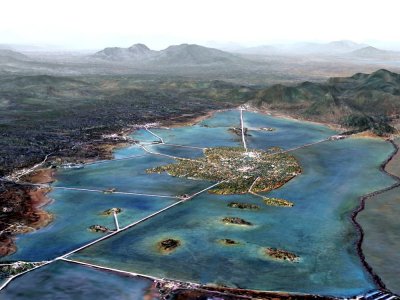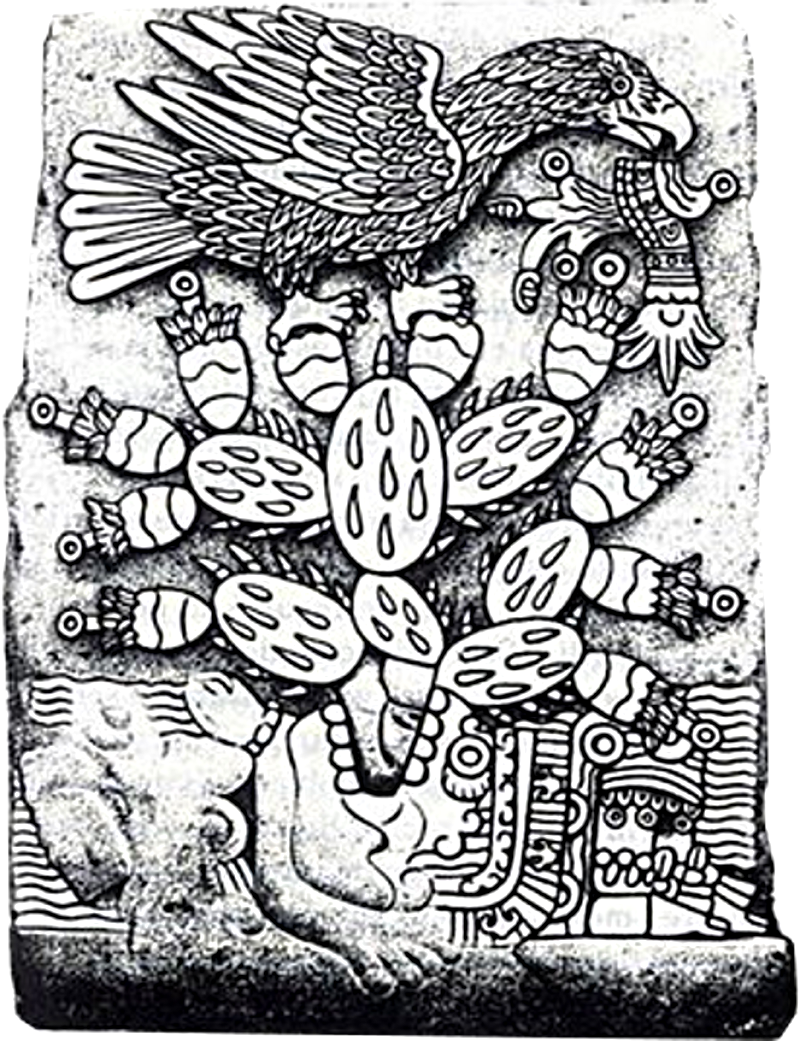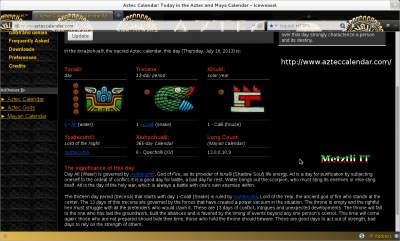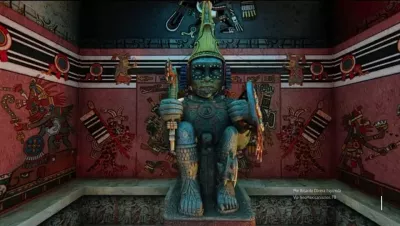Mexico-Tenochtitlan: July 18, 1325, Mexicah People Founded Modern-Day Mexico City
Please right-click on either image above to show video controls.
July 18, 1325, guided by their deity Huitzilopochtli, the Mexicah people's long journey from Aztatlan came to an end as they founded Mexico-Tenochtitlan. A marvelous engineering feat founded on an islet inside the great lake Texcoco, it was an extremely well planned and designed altepetl, or metropolis, and quite likely the largest and most efficiently run of its kind in the entire planet Tlalticpac (Earth).
Modern Mexico City has not even a shade of a semblance to what was once the great Mexico-Tenochtitlan altepetl. After its 'independence' from Spain in September 16, 1810, the colony of ruling Spaniard-descendants (criollos in Spanish dialect) even plundered the Mexicah's eponymous nation-state ethnic name to denominate the entirety of their dominion as well. Thus, hiding behind the mythological Mexico to advance their 'mother' country, Spain's, vicious 'culture', the New Spain oligarchy has only imposed corruption, religious fanaticism that blinds the masses to the abuses of the privileged church representing the elite, impunity based on institutionalized discrimination, and archaeological, environment and ecological destruction. All of these factors evidently combine to hinder and gradually degenerate -- rather than advance -- intellectual and human development of those inhabiting the now Spaniard-bastardized 'Mexico' colony.
"I am not leaving material patrimony for you and our son, ... I'm leaving you a moral and political legacy, dying as I am for a cause, in defense of the Mexican culture."
--Emmanuel D'Herrera
Nahuatl is the native language of Mexico. It was the language par excellence spoken by the true Mexicah people who founded Mexico-Tenochtitlan in 1325, 688 years ago. Yet in 1696, the Nahuatl language was banned in the New Spain by a decree of King Charles II of Spain. Notwithstanding, the New Spain continued to observe their king's decree even after their 'independence' from Spain in 1810 and their decision to be renamed as 'Mexico'. That is a subtle indication of whose directives are actually impulsed and implemented in Mexico, which have thus far caused irreversible damage even to the lake Texcoco itself --where the altpetl or metropolis was founded-- and by extension to its inhabitants.
Lake Texcoco... What Lake Texcoco?
"Pero de aquel majestuoso lago que se extendía desde el pueblo de Chalco, en el extremo sur, hasta el de Zumpango, en el límite norte, y que abarcaba cerca de 2 mil kms², hoy sobreviven sólo 10 kms²..."-- Aníbal Santiago
But of that majestic lake that extended from the pueblo of Chalco, at the extreme south, and reached the pueblo of Zumpango, at the northern limit, and which encompassed nearly 2 thousand kms², today only survive 10 kms²...
According to the Mexicah people's account of their long and arduous journey from Aztatlan (Place of the Herons), their revered deity Huitzilopochtli (Hummingbird of the South/Left) revealed a signal which predominantly guided them to their ultimate location. Prior to that, the Mexicah had been under the tutelage of Huitzilopochtli's sister, the great nahualli5 Malinalxochitl (Twisted Flower). It is said that the Mexicah underwent great suffering under Malinalxochitl's rule (possibly at Chiucomoztoc, i.e., 'Seven Caves',) and that they begged Huitzilopochtli to deliver them from her tutelage.
Huitzilopochtli instructed his people to abandon his sister when she were deeply asleep and the Mexicah, ephemerally relieved, heeded his advice. When Malinalxochitl awoke and saw herself alone, she became furious and violently reacted by pitting her son Copal against his uncle. It is said that Huitzilopochtli defeated his belligerent nephew, killing him in sacrifice by extracting his yollohtli (heart) -- which the Deity subsequently threw into the emptiness, falling somewhere into lake Texcoco. That was the gist of the sign that Huitzilopochtli conveyed to his people: the Mexicah were to establish Mexico-Tenochtitlan where Copal's yollohtli --which had sunk somewhere in the lake Texcoco-- seeded the nohpalli (wide-leafed cactus) that they were to spot somewhere in the vast lake.
Arguably, there was more to the nohpalli symbol: (Remember that we were very poetic...)
after the catastrophic destruction by the Spaniards and their indigenous allies -- bitter enemies of the Mexicah -- now it is difficult to really determine what the hieroglyphic images represent; yet by reading the explanation below you will get a better idea on how our people understood the universal connection, the aspects of nature, and relation the elements had with one another.
Let me shed some light on what will be stated below because, even though you will have read the [] insertions that follow, the meaning is deeper than that conveyed by the visual perception of an actual physical image (of an eagle perched on a nohpalli).
- We didn't actually see [] an eagle [] proudly perched on top of a nohpalli -- what we saw was a powerful place where the sun (represented by the eagle) shimmered down displaying a place of grand intensity.
- We saw and felt, at night, a spot where the moonlight gave off a lovely aura of feminine peace, a calming vibration, which was a reassurance that this was the place to build our new home.
- [] The sun (i.e., the eagle, which also represents fire) [] is regarded as masculine, and the moon (which represents water) [] is regarded as feminine; together these two powerful forces represent the atl-tlachinolli; allow me to give a very brief explanation of this word (atl) [] means water and (tlachinolli) means fire, in Nahuatl. Combined, fire and water mean war (or seeking of balance).
- The nohpalli represents the land and the thorns represent struggle.
- The three rocks, as said in the insert, is the triple alliance between Tetzcoco6, Mexico-Tenochtitlan, and Tlacopan.
Over the field of xoxouhqui7 (raw/green or blue color), i.e., sky, sovereignty irradiates Tonatiuh (the One who walks shining like fire, i.e., the Sun) as divine Metl (agave or maguey) and its blazing fire illuminates the Universe with his cihuametzin ('pencas' or rays) of light, (i.e., the Grand Gentleman who gives us life). In the center of the Sun [] transcends the august figure of Himself, and as in Teuhtihuacan on the so called perron of Quetzalcoatl we can contemplate the same solar symbol with His rays of light projecting what appears to be the head of an animal resembling an Ocelotl (jaguar), but which from a profile view morphs into a Cohuatl [Serpent] -- both symbols of the sun.8
Both (Ocelotl and Cohuatl) represent sovereign and dual divinity, yet in Tenochtitlan the sun is represented as a triumphant Cuauhtli [eagle], as described by P.Duran, J Acosta [1] and the Codex by Ramirez: 'In the early morning the eagle rises and extends its wings, absorbing the heat and the energy from the sun's rays while collecting the soothing coolness of the morning mist, and it held in its claws a magnificent bird of very precious and radiant feathers.' [2]
The eagle amplifies the solar --military-- shout. As the eagle shouts, it simultaneously disappears after giving life to the many inhabitants of the Anahuac (Surrounded by Water). The hieroglyphic, atl-tlachinolli, (which is misconstrued as a serpent/snake in the beak of a cuauhtli) corresponds with the symbols of water and fire, which over the course of generational ignorance and christian fanaticism have been distorted and confused with a serpent.
To the Nahuatl/Mexicah the prior misinterpretation is absurd, since the serpent is symbolic for [] divine wisdom (Quetzalcohuatl) and is a representation of Earth. This means the serpent could not have the solar eagle as an enemy for, if the eagle were to eat the serpent, would prevent (the serpent/snake) from fertilizing the earth.
Mexictli, where Metztli (the Moon) became Xictli (navel) to indicate the belly of our Mother Earth, is the place where the feminine light gives birth in blissful pleasure to our civilization; it is where the Mexicah encountered a rocky crag where metizintli [agave plants or magueyes] and nohpaltin are born. And perched radiantly on the nohpalli was a cuauhtli with its wings open and glaring -- as if challenging the sun -- intoning/chanting the shout 'Atl-tlachinolli!'. All the while proclaiming that mystical juncture where Cohuatl (Serpent) depicting Tlalticpac (Earth), Cuauhtli (Eagle itself), and Tonatiuh (Sun), are bound as one by the Great Being Huitzilopochtli. It was the symbology denoting the promised land.
10
Who created a system wherein one could rise upward only by repudiating one's native blood and exploiting native people?11
The destruction of the ancient Lake Texcoco by the fascist Spain settler spawn oligarchy's nefarious paradigm that prevails in the New Spain... er, 'Mexico', has been an overt attack at the quintessence of the Mexicah peoples' existence. Further, the desecration of revered ancient places like Teuhtihuacan, even by those whose main task should be the preservation of Mexico-Tenochtitlan ancient heritage but who in reality are unscrupulous corrupt individuals, is alarming. And the fraud-imposed politicians --who front for the stateless elite who rule Mexico from the shadows-- do practice a policy of deference to foreign interests; these, in turn, have engendered a climate of violence which is gradually destroying the fabric of Mexico's society.
Although normally I post about technology, I believe in the unfettered positive development of the human beings' potential. Thus, I will finally end this long post by encouraging the technological development of Mexicah people; they have endured 492 years of marginalization under violent institutionalized oppression and discrimination. Furthermore, the Spanish dialect apparently does not facilitate excellence in mathematics, science, and consequently, technology.11 Accordingly --for the real Mexico-- recovering its ancestral native language, Nahuatl, in addition to English Russian and/or Chinese --the languages that lead technology innovation-- might prove to be a superb combination, for...
The Mexicans are what they always have been -- Mexicans. Since (and before) 1520 they have absorbed many non-Mexicans (including other Anishinabeg as well as Asiatics, Africans, Spaniards, and so on); and their culture has changed (as do all cultures). Fundamentally, the Mexican people go back into history as far as we can see into the past. They have no need to explain their present status by denying their continuous past or by genuflecting before the shrine of mestisaje! The word Mexican historically means Aztec-Nahuan. Isn't that enough?12--Jack Forbes
References:
Mindscape3D Case: Mexico-Tenochtitlan Altepetl.
The Bribery Aisle: How Wal-Mart Got Its Way in Mexico
El gran lago moribundo de Texcoco
5Nahualli: the fanatic Spaniards usually reduced its meaning to their concept of sorceress
6Texcoco is also known as Tetzcoco
7
[Что представляет собой] маленькая сине-зеленая баночка, наполненная попкорном?... это небо ≈
[what is] a little blue-green jar filled with popcorn?... it is the sky
Nahuatl Dictionary definition by WiredHumanities: Xoxouhqui
8Note how the snake/serpent (apprehension) and the jaguar were dual symbols of the sun in Teuhtihuacan; but in Mexico-Tenochtitlan the snake is only associated with the Earth.
9Zozomoca(h): for a snake to hiss
10"Sent by Chiknawi Ejekatl" But I cannot locate the URL
11Update December 22, 2025.
This resource has been deleted by the arrogant, fascist, Spanish scum at its source: Jorge Edwards opina que "somos una lengua unida pero atrasada en ciencia y tecnología"
12Jack Forbes, The Mestizo Concept:...
DISCLAIMER:P although due diligence has been applied, the above post reflects an educated assessment of the dire situation faced by a marginalized and fragmented people.
Please do not hold me or Metztli Information Technology, or its associates, responsible if the information provided here does not achieve the desired result. The information is provided AS IS and with the hope that it may be useful to the target audience and the worldwide Internet community who may want to collaborate.
Notwithstanding, There is no implicit or explicit guarantee that the information presented here is accurate. You have been forewarned.
I reserve the right to modify the blog and even to delete it without further notice.
Follow up:












Recent comments: